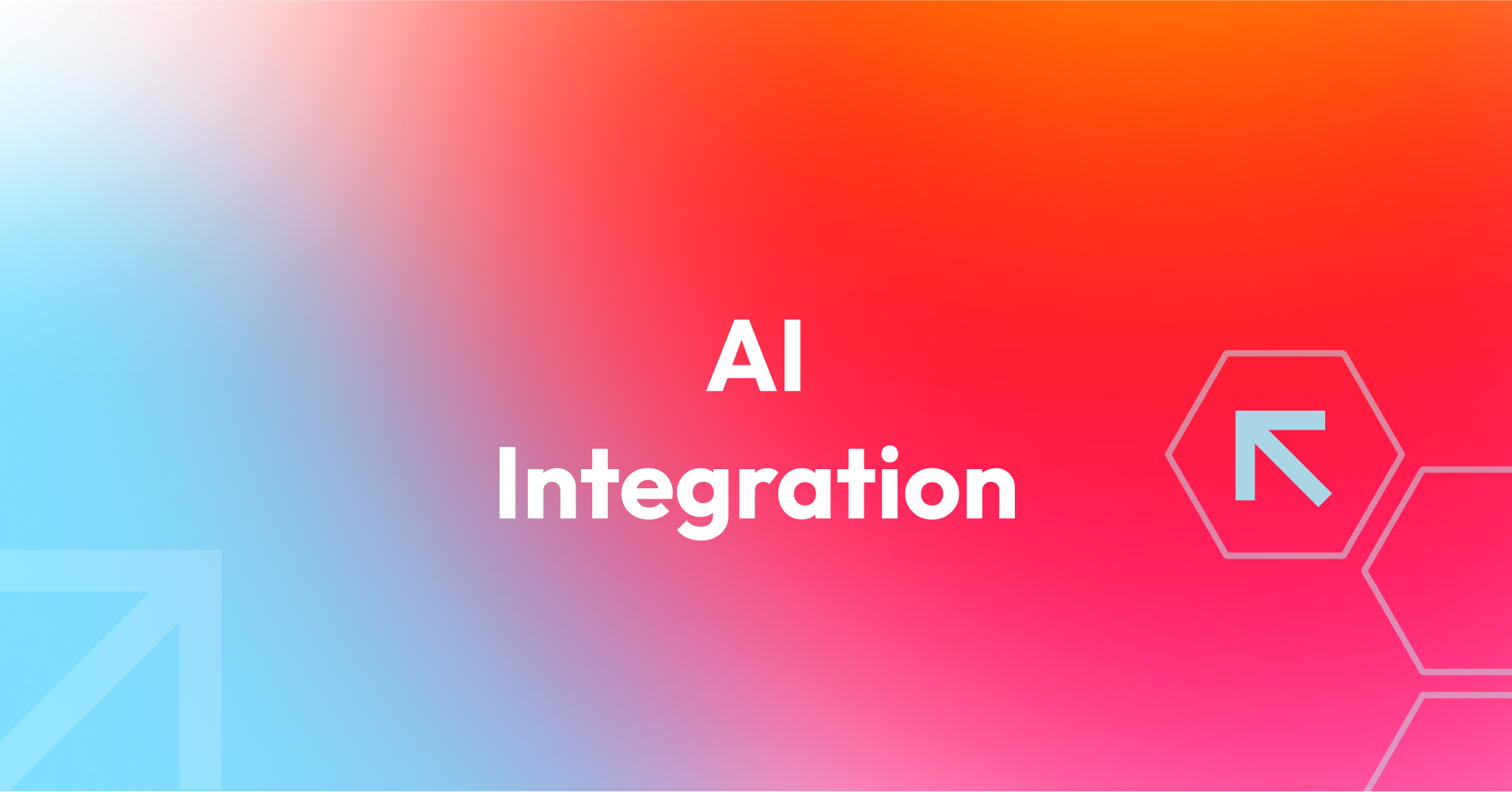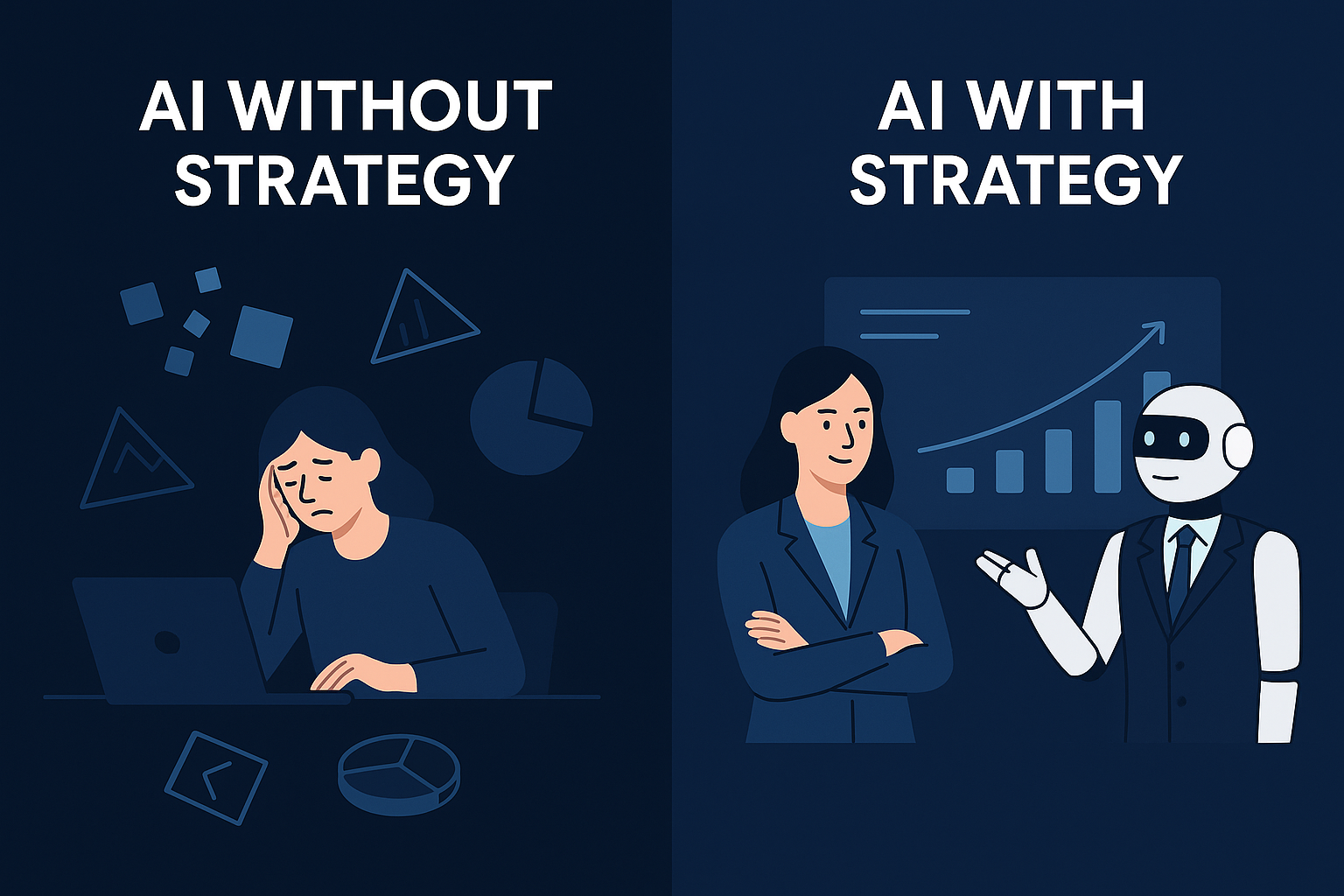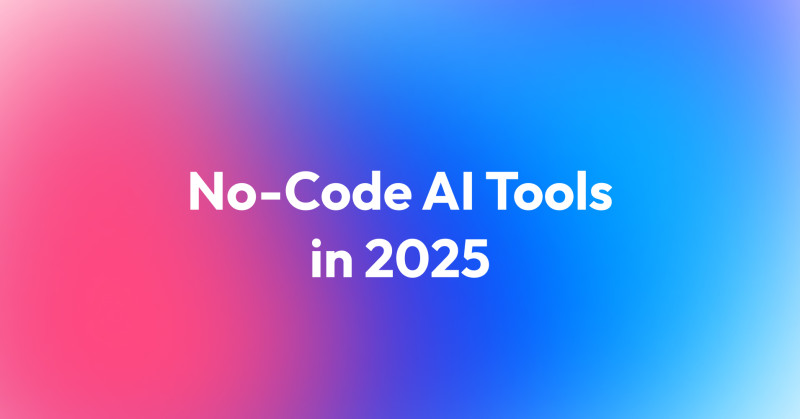Did you know that General Motors invested over $50 billion in robotics during the 1980s, yet AI integration failed because they neglected to upgrade their workforce? Today, we see Tesla facing similar production challenges with their total automation strategy. Despite the tremendous potential of AI to transform businesses, many integration projects fall short of expectations.

The truth about integrating AI in business
The truth is that integrating AI in business doesn't have to be overwhelming. With a structured roadmap and quality data, organizations can successfully weave AI-driven solutions into their daily operations. In fact, when properly implemented, AI integration services can drive competitive advantages through personalization, efficiency, and enhanced decision-making.
By following an eight-step approach, we can address common challenges like legacy system constraints, disorganized data, and ethical concerns that typically derail AI and machine learning integration projects.
What this article covers
Throughout this article, we'll explore how to:
-
Align your generative AI integration with business goals
-
Prepare your data infrastructure
-
Choose the right implementation approach
-
Establish continuous monitoring systems to ensure success
Step 1: Align AI Projects with Business Strategy
Research reveals a sobering statistic: over 80% of AI projects have failed or will fail soon. The difference between success and disappointment often hinges on one critical factor—strategic alignment.
Identify high-impact use cases like customer service or supply chain
Successful AI integration begins with identifying specific business problems rather than implementing technology for its own sake. Instead of asking "How can we use AI?" ask "What business problems need solving?"
High-impact use cases typically include:
-
Customer service enhancement: AI-powered solutions can increase issue resolution by 14% per hour while reducing handling time by 9%. Companies like Wendy's and Uber are managing orders faster through predictive AI tools.
-
Supply chain optimization: AI can significantly improve demand forecasting, inventory management, and logistics. Toyota implemented an AI platform that reduced over 10,000 man-hours annually, while other organizations use AI to predict supply chain disruptions before they occur.
-
Operational efficiency with intelligent automation: AI can automate repetitive tasks in various departments, from HR to manufacturing. For instance, AI enables automotive manufacturers to effectively predict and adjust production based on supply and demand changes using predictive analytics.
Engage stakeholders across departments
Cross-functional collaboration is essential for AI integration success. Beyond data scientists and IT specialists, involve:
-
Business unit leaders who understand strategic objectives
-
Domain experts with hands-on process knowledge
-
End users who will interact with the technology
According to research, 75% of leaders whose teams use AI report better collaboration. Furthermore, enterprises see the most success when AI projects involve cross-functional teams invested in outcomes and sharing responsibility throughout the entire lifecycle.
Set success metrics from the start
Before implementation, establish clear goals and measurable KPIs that align with business objectives. This ensures your AI initiative delivers tangible value rather than becoming an expensive experiment.
Effective metrics might include:
-
Reduction in operational costs by specific percentage
-
Improvement in customer satisfaction scores
-
Decrease in manual process errors
-
Increase in sales or customer retention
Additionally, business operational KPIs help objectively assess AI model performance, align initiatives with business goals, enable data-driven adjustments, and demonstrate overall project value.
Remember that improving one metric might affect another. For example, retailers may see increased cart size with more engaging chatbots, although time-to-cart might also increase. Therefore, context and industry expertise remain critical when interpreting changes.
Step 2: Prepare Your Data and Infrastructure
The foundation of successful AI integration lies in the quality and organization of your data. Organizations typically spend only 20% of their time analyzing data, while the remaining 80% is consumed by cleaning and preparation. This crucial groundwork determines whether your AI implementation thrives or joins the ranks of failed projects.
Clean and consolidate internal data sources
Data fragmentation across multiple platforms creates silos that impede holistic insights and strategic decision-making. To address this challenge:
-
Standardize empty values by converting variations like '?', 'Missing', and 'N/A' into a consistent format
-
Remove redundant fields when two fields show complete correlation
-
Address outliers at both field and record levels, as they can significantly disrupt AI/ML pipelines
For organizations with large datasets, automated cleaning pipelines offer efficiency gains while maintaining quality. These systems can process massive volumes efficiently, reducing turnaround times and enforcing consistent rules and procedures.
Ensure data privacy and access controls
As AI systems grow increasingly data-hungry, privacy concerns intensify. Without proper controls, your organization risks exposing sensitive information while potentially violating regulations.
Privacy protection requires a multi-layered approach:
-
Implement robust data governance policies with clear guidelines for usage and security
-
Establish data classification systems that categorize information as public, internal, or confidential
-
Deploy privacy-enhancing technologies (PETs) that protect personal information
Access control systems should identify and authenticate users while ensuring they can only view data appropriate to their role. This becomes especially crucial when AI systems process sensitive customer data or proprietary information.
Select storage solutions that support AI workloads
AI applications require specialized storage infrastructure that can handle their unique demands. Key requirements include:
Scalability: Your storage must accommodate exponential data growth, particularly unstructured data like images, videos, and text.
Performance: AI workloads demand high throughput and low latency to support rapid retrieval and processing of data.
Integration: Storage solutions should seamlessly connect with your AI frameworks such as TensorFlow, PyTorch, and Spark ML.
Ultimately, your infrastructure choices must balance performance requirements with cost considerations. Options range from on-premises databases to cloud-based data warehouses and distributed file systems, each offering different advantages depending on your specific AI integration needs.

Step 3: Choose the Right AI Integration Approach
After establishing your strategic direction and data foundation, selecting the optimal AI integration approach becomes your next critical decision. This choice substantially impacts implementation timelines, costs, and ultimate success.
Build vs buy: when to use AI integration services
The build-versus-buy decision involves evaluating several key factors:
Strategic importance: If AI capabilities differentiate your core business, building custom solutions may protect your intellectual property. As one expert notes, "If it's something that differentiates you... you probably want to own that IP". Conversely, for standard functions, off-the-shelf products often prove more efficient.
Cost considerations: While buying appears more expensive initially, building without clear strategy often costs more. Custom development requires significant investment in specialized talent—data scientists, engineers, and domain experts—plus computational resources and training data.
Implementation timelineBuying enables faster deployment of cutting-edge technology, critical when time-to-market matters, especially in the realm of artificial intelligence. Simultaneously, custom development might better align with long-term growth, potentially resulting in lower total ownership costs at scale.
Select models based on task complexity and transparency
Model selection should match your specific use case requirements:
Task complexity assessment: For straightforward tasks, simple models with lower latency might suffice. Complex problems involving multi-step reasoning typically demand more sophisticated models like GPT-4.5 or Claude 3.7 Sonnet.
Transparency needs: Some applications require explainable AI decisions, particularly in regulated industries. Balance model capability against interpretability requirements based on your specific use context.
Operational factors: Consider context window limitations, processing speed, and cost efficiency. Models charge differently for input and output tokens, significantly affecting operational expenses.
Use pre-trained LLMs for faster deployment
Pre-trained large language models offer several advantages:
Accelerated implementation: Pre-trained models dramatically reduce development time by leveraging existing capabilities trained on massive datasets. This approach enables organizations to integrate sophisticated AI functionality without extensive training resources.
Reduced data requirements: Using pre-trained models minimizes the amount of data needed for your project. Through techniques like retrieval-augmented generation (RAG), you can enhance these models with your proprietary information without extensive fine-tuning.
Integration options: Pre-trained models can be accessed through APIs, embedded in existing enterprise applications, or customized through fine-tuning. Each approach offers different balances between customization, control, and implementation speed.
Step 4: Launch, Monitor, and Scale
Moving from planning to execution marks a critical juncture where many AI integration projects falter. Only 11% of companies have successfully adopted generative AI at scale, highlighting the importance of a methodical implementation approach.
Run pilot tests with real users
Begin with a controlled pilot implementation rather than immediate enterprise-wide deployment. Subsequently, select a specific department or limited user group to minimize disruptions. This approach allows you to:
-
Test the AI solution in a controlled setting without affecting broader operations
-
Use agile methodologies for real-time adjustments based on initial results
-
Measure the solution against pre-defined KPIs and objectives
Starting with manageable scope builds confidence and expertise, ultimately paving the way for more ambitious AI projects.
Track model performance and user feedback
Once deployed, AI systems require continuous monitoring to maintain effectiveness. Set up dashboards to track performance metrics, given that:
-
Model degradation occurs naturally as data and business requirements evolve
-
Data drift happens when statistical properties of input data change, affecting prediction accuracy
-
Prediction drift indicates changes in model outputs that may signal declining performance
Alongside technical metrics, collect feedback from users and stakeholders. This integration process allows for continuous refinement and enhancement of your AI system's capabilities. User insights help identify usability issues and areas where models may be underperforming.
Plan for continuous improvement and retraining
As world events and user behaviors shift, models that normally take months to degrade can deteriorate more rapidly. Consider these retraining approaches:
-
Periodic retraining: Schedule model updates at specific intervals, useful when data changes follow predictable patterns
-
Trigger-based retraining: Automatically retrain models when performance drops below predetermined thresholds
Continuous learning architectures enable your system to grow in response to the changing nature of the world. Nevertheless, this approach requires careful monitoring to ensure models remain up-to-date without prohibitively large dataset requirements.
Conclusion
Throughout this article, we explored why most AI integration projects fall short despite massive investments and significant potential. The difference between failure and success ultimately comes down to structured implementation rather than technology itself. Companies must recognize that AI integration requires careful planning across multiple dimensions.
Strategic alignment stands as the critical first step, ensuring AI projects address specific business problems rather than pursuing technology for its own sake. Data quality, consequently, becomes the foundation upon which successful AI applications are built. Without clean, accessible, and properly stored information, even the most sophisticated models will underperform.
Making the right choice between building custom AI solutions or purchasing existing services depends heavily on your specific business context. The decision affects everything from implementation timelines to long-term costs and competitive advantage. Therefore, this step deserves thoughtful consideration based on strategic importance, budget constraints, and time sensitivity.
Launching with a pilot approach, furthermore, allows for practical testing and refinement before full-scale deployment. This measured strategy reduces risks while providing valuable insights for continuous improvement. Indeed, ongoing monitoring and retraining represent perhaps the most overlooked aspects of successful AI integration.
The journey toward effective AI implementation certainly presents challenges. However, following these structured steps significantly increases your chances of success where others have failed. Should your organization need assistance with AI integration in your company, contact us to discuss how we can help navigate these complexities together.
The future belongs to organizations that successfully harness AI capabilities while avoiding common pitfalls. Your company can certainly be among them with the right approach, adequate preparation, and commitment to continuous learning and adaptation.
FAQs
Q1. What are the main reasons AI integration projects fail? AI projects often fail due to poor strategic alignment, inadequate data quality, lack of proper infrastructure, and insufficient monitoring. Successful integration requires careful planning, clean data, the right implementation approach, and continuous improvement.
Q2. How can businesses align AI projects with their overall strategy? To align AI projects with business strategy, companies should identify high-impact use cases, engage stakeholders across departments, and set clear success metrics from the start. This ensures AI initiatives address specific business problems and deliver tangible value.
Q3. What role does data play in successful AI integration? Data quality is crucial for AI success. Organizations should focus on cleaning and consolidating internal data sources, ensuring data privacy and access controls, and selecting storage solutions that support AI workloads. Without proper data preparation, even sophisticated AI models will underperform.
Q4. Should companies build custom AI solutions or buy existing services? The decision to build or buy depends on factors like strategic importance, cost considerations, and implementation timeline. Custom solutions may be preferable for core business differentiators, while off-the-shelf products can be more efficient for standard functions. Each approach has different implications for timelines, costs, and competitive advantage.
Q5. How can organizations ensure long-term success of their AI projects? Long-term success requires ongoing monitoring and improvement. Companies should run pilot tests with real users, track model performance and user feedback, and plan for continuous improvement and retraining. This approach helps adapt to changing data patterns and user behaviors, ensuring AI systems remain effective over time.





















